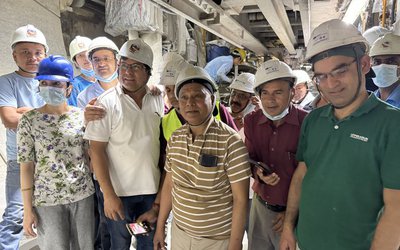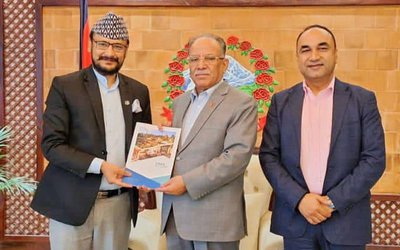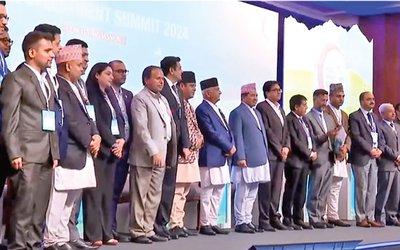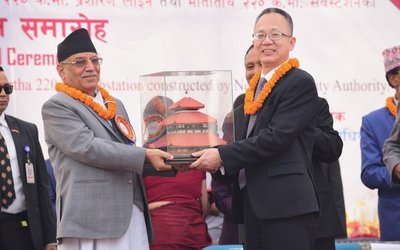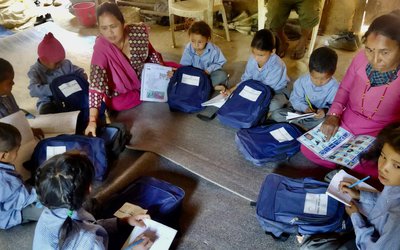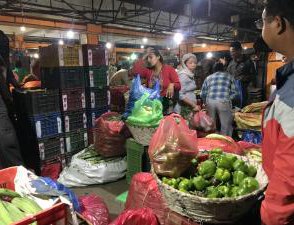
The government seems much pro-active in Kalimati vegetable and Fruits Market and Balkhu Agriculture Vegetable market since few months. I was doing wholesale market research of vegetables for a few months and most of the news was an additional checklist for me to search and verify during my research. But once I went deeper to the wholesale market studies based on Kalimati, Balkhu and few satellite markets in the Kathmandu valley, I am surprised to find that the current actions of the government is no more than just the public stunt rather than the long-term solution. There is a huge gap between how much farmers get and how much consumers are compelled to pay, but the entire blame for the rocketing price of the vegetables and rampant management of the wholesale market to the middle person or agent is not justifiable. It is true that the middle person is part of the problem, but they are not the only problem creator rather they are among the component of the corrupt system, and the government shouldn’t try to hide its incapability by blaming entire things on the head of the middle person.
There is plenty of news stating that the agriculture products are compelled to pass through 5 steps to reach the final consumer from the producer, which is absolutely true, but the information of what made it a compulsion for vegetables/agriculture products to pass through those 5 steps is completely missing. I got to read in the news that the government is in the process to scrap the agreement with 98 wholesalers/stalls on the charge of reselling the stalls in high price. I am not sure whether the government has that willing authority to implement the plan to scrap the agreement or not, but my major concern is whether that brings a sustainable solution to the existing problems in the Kalimati market or not. Everyone knows that the Kalimati and Balkhu market are not being able to do what it was supposed to do which benefits the larger people. And all of a certain appearing in the market and threatening the wholesalers wouldn’t bring a sustainable solution, so we better need to find the cause of the problem before jumping to celebrity style of actions.
It is true that the more number of steps involved in the vegetable market, the more expensive vegetable becomes, but the majority of the steps are not created by the middle person or agents alone rather it is the demand of the existing circumstances. The problem with the existing haphazard system begins right from the status of the farmers. Nepal doesn’t have ample large scales commercial farmers. It means most of our vegetable product comes from small-scale seasonal farmers. Each farmer has a limited variety of products and also in the limited quantity. The government has introduced a subsidy for commercial agriculture loans programme from the fiscal year 2014-15, but still getting a loan from commercial banks in low interest to the farmers is a daydream. In this situation, it is financially infeasible for farmers to take their limited products directly either to the consumer or wholesalers due to high transportation cost, different hassles on the way, minimum timing to deliver the product and many more. There is no any insurance policy for the farmers on their products, and if the product gets damaged or occurs accident, there is no way for farmers to get the backup support. Thus, these all situation makes farmers compel to dump their product in the collection center nearby at whatever price they get. Here, even the collection center is one of the steps which causes an increase in the price of the vegetable and is the need of the system. And if we need service from some people or institute, then it is natural that they seek profit and it is the same thing that collection center has done.
Now let us talk about the transportation. We all are aware of the condition of the roads in the capital city and also the rural areas. It is the duty of the government to maintain the roads, which is safe to the people, as they are collecting huge taxes from the people, rather exhibiting drama to control the fare of the vehicle. Private transport companies and also the private vehicles working to transport vegetables from different collection centers to Kalimati and Balkhu market is taking the risk of vegetables, their own vehicles and also the life during the rainy season. Most importantly, the vehicle carrying the vegetable needs to arrive Kalimati market by 2: 00 am early in the morning, and we all know the status of the roads. For taking all these risks and providing the services, aren’t they allowed to charge for their service? Definitely, they need to charge. If the roads were good and all-weather roads, lights on the road, and also the security, then in such situation if the vehicle fare were expensive then we can blame transport for the artificial hike of the transportation cost, but it is not the existing situation which we all know. Thus, who is responsible here, government or the private transport provider for an increase in the price? It is the major question.
Here, the private sector is helping the government on their personal risk and charging their price towards the service. This transport is also an agent or middle person for normal understanding, but I say that it is unavoidable. Despite the government’s support, whatever is the price, the people of Kathmandu valley are getting vegetables. So here, do we need to thank such private initiatives or we should put “Agent” tag on them and try to eradicate from the loop?
The Kalimati wholesale market was established in 1986 and current infrastructure was constructed on the 1990s with the assistance from UNCDF. There are no such measurable changes in the infrastructure since then. The population of Kathmandu has increased by many folds since the 1990s, but either there is new wholesale markets or improvement and extension of the existence wholesale market at the level to address the public demand. Thus, in this scenario, the space at the Kalimati is scared resource and scare resource has high value. And it is the reason for the unofficial transaction of the stalls at a very high price. It is natural for the unofficial transaction of the stalls, no matter how strict rules the government makes, it will operate until the resource is scarce. It not only applies in case of Kalimati or the vegetable market, it is the same with many other things and not only in Nepal. Here, the major problem is not on the reselling of the stalls in the higher prices which caused an increase in the price of the vegetables. The crux of the problem is the limited infrastructure.
Kalimati and the Balkhu vegetable market operates at 2: 00 am early in the morning, and most importantly the vegetables that they bring for the day needs to be completed within that day because there is neither storage facility or cooling facility which helps to preserve the vegetables that can be sold for the next day. There are tons of vegetables dumped everyday form Kalimati and the Balkhu market. The price of the dumped vegetables are shared with farmers (so that they get less price to their product), consumer (they need pay high for what they buy), and also the wholesaler (they earn less profit). This is not the created problem by anyone, but it is due to lack of modern tools and technologies and lack of initiatives from the government. I am sure the respective government bodies and the authorities to look after Kalimati vegetable and fruits market has knowledge on the available technologies to preserve the vegetables, but due to lack of initiatives being staying in the position, we people (farmers, agent, wholesalers, and consumer) are compelled to bear the cost.
Retailer market they reach Kalimati by 3: 00 am in the morning to get vegetables for public bearing all difficulties, risks in the public vehicle. Once they bring a vegetable to their store, it is said that minimum 5- 10% gets damaged on the way because of bad road, worst public transportation, lack of proper vegetable carrying vehicle and equipment like a crate. Thus, it is not the will, but the compulsion of the retailers to increase the price of the vegetable adding all those losses too. Thus, here again, the retailer is not the problem rather the infrastructure is the major problem.
Most importantly, the existing problems in the vegetable market network are not created overnight, it is due to incapability of the government and its respective bodies; Ministry, department associated with it to regulate the market regularly. In an interview, one of the respondents stated that he needs to knock the door of very senior political leaders to get a stall in the Kalimati market. It shows, that how much politicized is the market itself. Thus, the problem created as a result of long mismanagement can’t be solved overnight. There are other many issues that we need to see from a different angle. Thus, monitoring once in a full-moon and threatening the service providers; wholesalers and agents is not a sustainable solution to the existing market. I am not favoring the agents/middle person here. I too believe that decreasing the tire and enforcing strict laws and regulation will help the larger population, but I am just trying to point that the government steps are completely wrong and one-sided and that steps need immediate correction for the long-term solution.
In order to improve the existing situation of the market first, the respective division or units of the government should accept themselves as one of the major reason for the existing problem. Then the respective bodies should be activated so that it will regularly monitor and regulate the market from now onwards.
Second, farmers should be given subsistence loan to increase their business volume. Similarly, farming training and market information should be given to the farmers. The farmers’ product should be insured so that if any accident in occurs (natural or by people’s involvement) and the product gets destroyed, that loss should be reimbursed through insurance. In this way, farmers will retain and expand their involvement into the profession.
Third, and very important intervention would be to create better infrastructure, both in the collection center and the wholesale market. Considering the population of the Kathmandu valley, establishment of big hotels and inflow of people to the valley, still we need 4-5 big wholesale markets like Kalimati. The government should create such wholesale market in different strategic locations so that the pressure to the Kalimati and Balkhu market will be automatically released, and the reselling of the stalls in the Kalimati or Balkhu will eradicate on its own. Similarly, such developed new market should have infrastructure like; cooling machine, proper storage, enough parking space, waste management stations, pesticide monitoring station, real-time data management system on the price, volume and the source of the products. This system will create pressure on the Kalimati and Balkhu market to come into the system, and if they deny coming into the system, the creative destruction will work on them.
Fourth step would be an improvement of the collection centers in different parts of Nepal. Farmers should get the payment on receiving the goods and that data has to be recorded by modern means of technology. In this way, farmers wouldn’t need to bear the loss that in occur during transportation mishandling. Pesticides monitoring device is should be made compulsory in all the collection center, so that, excess pesticide products wouldn’t get access to the market itself.
Fifth step would be given preference to the vegetable carrying vehicle to ply in the early morning time in the Kathmandu valley. It is found during research that they need to bribe different agencies; checkpoints and also on the way for security reasons while transporting the vegetables. Such corruption should be controlled and security should be ensured to the transport people.
Sixth step would be to bring a middle person into mainstream business. The knowledge, network and the experience of the middle person is a highly valuable resource to strengthen the market. If these people can be brought into the mainstream, it will be easy for the government to regulate the market.

Nabraj Lama
Independent Researcher, Kathmandu. He can be reached at nabrajlama@gmail.com
- Mahakali Treaty And Nepal-India Water Relations
- Jan 07, 2019
- Pancheshwor: Under A Prolong Controversy
- Sep 03, 2018

